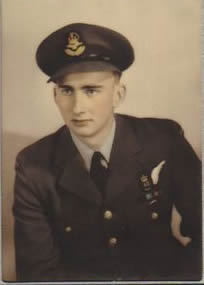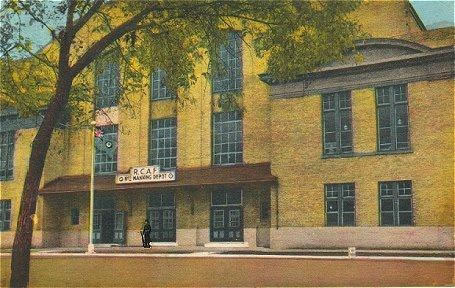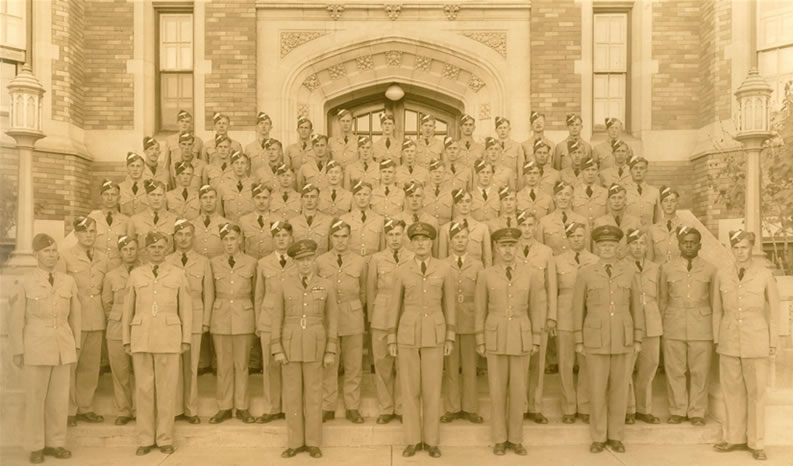Jim McPhee- My story Page 1
 |
Introduction
Several persons have asked me to write down my experiences in the Royal Canadian Air Force during world war two. As in most experiences, there was good and bad, but the bad ones were very bad, which, I believe made me reluctant to share them with anyone. Perhaps I felt a little guilty because I survived intact and so many of my friends lost their lives. Especially I feel badly about the members of my crew, who perished [except one, the pilot], and seeing that I was there to protect the aircraft, I felt that I had failed them. A few years ago, I attended the Allied Air Force reunion at the Royal York hotel, met many who had been through the same battle and for the same reason. Talking with these veterans about the whole experience, and hearing some of the feelings they have experienced, made me realize that we all tried to do the best job we could, and the bad outcomes were not all our fault.
People we care about, need to know the personal stories of the war, to counter act some of the misinformation the so-called historians (as those at the National Film Board) have spread through such as "The Valor and the Horror" and "Death by Moonlight". |
Signing Up
March 18, 1943, I turned eighteen years old, and the following week I went by train from Sault Ste. Marie to North Bay, and enlisted in the RCAF. Of course, I talked this over with my parents, who certainly tried to dissuade me. My education would have to be put on hold. It was mid term grade twelve, which would not be completed until the end of June. However, I was finding school very difficult as I had to make enough money to pay my room board and books. I was working at the Algoma Steel plant as a so-called "Victory worker" Putting in about thirty six hours weekly probably the reason I was determined to go to war was for adventure, or to escape the hard time I was having (working and going to school) or it was general restlessness. There was the pressure of being young and able bodied, so that the expectation was that one would go to defend the country. Who knows?
I was a member of the Air Cadets, which met once a week at the Sault armories, where we wore a uniform, paraded, and learned about flying and aircraft. Some of the members of the Air Cadets had joined, and more talked about it. There were several young men met at the recruiting office, along with me, transported to the railway station and were on our way to North Bay Induction centre. We arrived early in the morning, spent the day having medical examinations, having educational documents scanned, and then were back on the train for Toronto the same evening.
Manning Depots
From Union Station, we were taken to the Exhibition grounds in Toronto, by an NCO who showed us how to walk in a military form. Our first home was the live stock building, the "Sheep Pen" to be exact, which was the "Reception Centre", set up to take in the raw recruits. We were confined to barracks for the first two weeks while we received our uniforms, medical examinations, induction lectures, and introduced to military discipline. Transition from civilian life was a bit of a shock especially for those who had lived a more sheltered life than I had. Actually, I had left home in 1941 to go to school in Burlington so that I had knocked around a bit and did not suffer the terrible home sickness that some experienced. If you have been to the Exhibition in Toronto, you will be aware of the huge buildings with open floor space. In one huge building there were six thousand men in double deck bunks.
Military life consists of large numbers of rules and regulations, which had to be obeyed, and as long as a person complied, it was not unpleasant. Having survived the induction process, we were moved to the “Horse Palace”, next to a large group of young men from Quebec, who were there to learn English. As a matter of fact they were referred to as the School of English. At the same time they were going through basic training or “boot camp”, physical, educational, and military drill. About half way through basic training, I came down with tonsillitis and lymphadenitis, requiring a few days in sick bay. By the time I recovered, my group had moved on, and I was an odd man out, so I was posted to Brandon Manitoba to complete my manning depot stint.
Toronto manning depot was an enjoyable experience, the camaraderie, the physical challenge of basic training, and the excitement of the big city was great. The food was good, beds comfortable, and visits with my relatives very pleasant. My aunt Marion White and my uncle John McPhee, my father’s siblings lived in Toronto, and always welcomed me to their home.
No 2 Manning Depot, Brandon, Manitoba, flying the RCAF flag, and with a uniformed soldier in front.
 |
In Brandon life continued much as it had been in Toronto. The trip from Toronto to Brandon, through Northern Ontario bush country, along Lake Superior and the lake country from Thunder Bay was very impressive, especially for the first time. One of the most memorable things about Brandon was the absolutely awful food that we were given. Some time after I had left there the officers in charge of the food were court-martialed for stealing supplies and selling them to a local restaurant. Sports programs were carried out as part of our training, and we were regularly entertained by various celebrities, Marlene Dietrich visited, and entertained, giving a very impressive concert. She reputedly had the most perfect female lower limbs in show business. |
The parade ground at Brandon manning depot was known as the gopher patch. Apparently there was a gopher town there before the military came; the gophers did not want to leave. As a consequence, care had to be taken to avoid stepping into a gopher burrow.Having completed basic training, I was selected for aircrew training but the initial training schools were full at that time. As a result, we were assigned to so called general duties, and posted to Dauphin, Manitoba a service flying training school, where student pilots were doing the second phase of their flying training. Here, on the station, was a large vegetable garden to which I was assigned, my weapon being a hoe and a rake, this was obviously a make work project to keep the waiting airmen busy and out of trouble.
View Larger Map |
A. Toronto, Ontario |
| B. Brandon, Manitoba |
| C. UBC, Vancouver BC |
| D. #7 ITS Saskatoon, Saskatchewan |
| E. Flying Training, Davidson, Sk |
| F. McDonald, Manitoba #3 Bombing & Gunnery School |
UBC, #7 ITS, Saskatoon, and Davidson, Saskatchewan
After two weeks, we were shipped out to the University of British Columbia to upgrade our mathematics, learn some basics of navigation and some signaling. Discipline was much easier, the weather was great, the beach was nearby and Vancouver was lively. Exploration of Stanley Park occupied many off hours, as it seemed to be populated by friendly young women with tandem bicycles. We were at UBC for about four weeks or so when the Number 7 I.T.S. accepted a new class for the academic part of flying. This school taught the expected subjects for student pilots and navigators. Our group was designated course #84, and I was in E flight. The subjects included the principles of flight, navigation, firearms, meteorology, aero engines, aircraft recognition and lots of physical training and military drill. At the end of this experience which lasted eight week, we were selected for further training as either a pilot or a navigator, and sent to appropriate training stations. I was selected for pilot training. It was a very enjoyable and interesting experience. I have always fondly remembered my stay at Saskatoon and # 7 ITS.
No. 7 I.T.S. RCAF Saskatoon Saskatchewan Course 84, "E" Flight September, 1943

Run your cursor over the image to see the names below each face. (Image courtesy of Jim McPhee)
|
FR: Sgt.Harcourt, A; F/S Gillings, A;. S/L F.R.O.McCall, DSO, MC, DFC; W/C L.C. Russel, MC; F/L R.D.Phillips; F/O H. Wagner; A/C2 Baines (Flight Senior)
2nd Row: AC2 Barton, F.; Negson, N.; Shirray, H; McConnell, R.; Waters, R.; Warren, D.; Levenstein, R.; Monarski, S.; McWilliams, A.; Ballantyne, A.; Meadows, S.; Henderson, E.
3rd Row: Weins, N.; McLeod, W.; Reid, W.; Wilkins, G.; McPhee, J.; Underwood, J.; Williams, H.; Roberts, A.; Kirkland, A.; Sullivan, H.; Winhall, R.; Cross, N.
4th Row: Primeau,C.; Taylor, E.; Switzer, J.; Toombs, G.; Wheeler, T.; Gemmel, D.; Davidson, W.; Reynolds, S.; Baron, W.; West, J.; Kramarchuk, P.
5th Row: Gillespie, T.; Estabrook, H.; Fritz, A.; Muir, W.; Delisle, J.; Turner, S.; Hawksbee, A.; Hawkes, P.; Thompson, W.; Wilson, J.; Garriock, D.; Stokes, J.;
Back Row: Mollard, F.; Anthony, F.; Jones, D.; Barefoot, D.; Todd, I.; Moore, J.; Wallbridge, P.; Blankstein, M.; Moorhouse, F.; Richardson, G.; Farr, J.; Bate, D. |
My next stop was at elementary flying training school at Davidson Saskatchewan, which is located about halfway between Saskatoon and Regina, in the heart of the prairie wheat fields. Being around the beginning of Sept. 1944, the wheat was about ready to be harvested. Autumn weather was bright sunlight, clear skies, and warm days. The station was equipped with Fairchild Cornell trainers, single engine monoplanes, and easy to fly. My flying instructor was a Flight Sergeant McLeod, a quiet reserved person, who was a patient teacher, positive and encouraging in outlook. We continued our theoretical class room work as well as being introduced to actual flying. There was a great urgency to the process of learning to fly, and any difficulty experienced by the student had to be overcome quickly because of the high rate of casualties in the theaters of war. I had difficulty with landing, tending to come in too high, and having to fly onto the ground rather than making the desired three point landing that was required. After a few hours of solo time, my performance was checked out by the chief instructor, who told me that I was not progressing fast enough with the landing procedure and that I would have to remuster to another air crew skill.
Jim McPhee- My story Page 1

